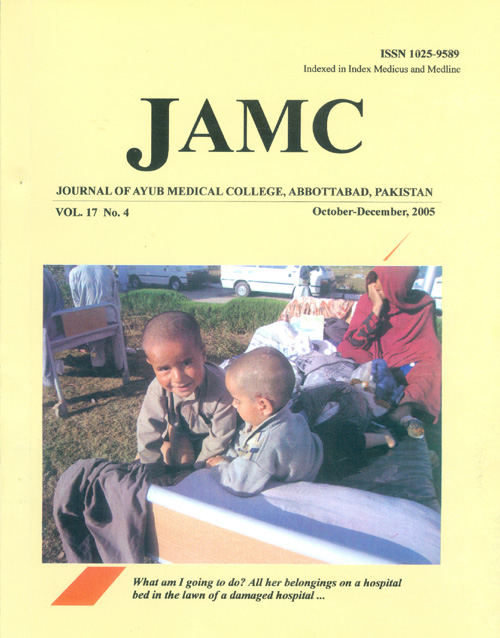FREQUENCY AND RISK FACTORS FOR WOUND DEHISCENCE/ BURST ABDOMEN IN MIDLINE LAPAROTOMIES
Abstract
Background: Wound dehiscence/burst abdomen is a very serious postoperative complicationassociated with high morbidity and mortality. It has significant impact on health care cost, both forthe patients and hospitals. The aim of the study was to determine the frequency of wounddehiscence/burst abdomen in patients undergoing emergency and elective laparotomies throughmidline incisions and to identify the risk factors for wound dehiscence. Methods: This study wascarried out at department of General Surgery, Pakistan Institute of Medical Sciences, Islamabadfrom 1st January 2002 to 31st December 2002. 117 consecutive patients undergoing laparotomy withmidline incision were included. They were followed by wound examination from third postoperative day onwards to see their normal or otherwise healing. Results: Seven out of 117 (5.9%)patients developed wound dehiscence. Five of them (4.2%) were operated in emergency and two(1.7%) were operated on elective list. Conclusion: It is very clear from our study that frequency ofwound dehiscence/burst abdomen is still very high in our hospital. Peritonitis, wound infection andfailure to close the abdominal wall properly are most important causes of wound dehiscence.Malnourishment and malignant obstructive jaundice predispose a patient to wound dehiscence byslowing the healing, and increasing rate of wound infection.Key words: Burst Abdomen, Wound Dehiscence, Laparotomy.References
Moosa AR, Lavelle-Jone M, Scott M. Surgical
complications. In: Sabiston DC (ed): Textbook of surgery:
the biological basis of modern surgical practice. 13th ed.
Philadelphia. W.B Saunders, 1986; 331-45.
Al Falouji MAR. Postgraduate Surgery the candidate’s guide.
nd ed. Oxford: Butter worth-Heineman, 1988; 196-7.
Adrian S, Peter L. Wound dehiscence incisional hernia and
para-stomal hernia. In: Moris PJ, William W (eds): Oxford
Textbook of Surgery. 22nd ed. Oxford University Press, 2000;
-90.
Glona JL, Bendick PJ, Link WJ. The use of thermal knives in
surgery: electro surgery, laser, plasma scalpel. Curr Prob
Surg 1978;15:01-78.
Efron G. Abdominal wound disruption. Lancet 1965;1:1287-
J Ayub Med Coll Abbottabad 2005;17(4)
Hanif N, Ijaz A, Niazi UF, Akhtar I, Zaidi AA, Khan MM.
Acute wound failure in emergency and elective laparotomies.
J Coll Physicians Surg Pak 2000;11:23-6.
Bannerjee Sr, Daud I, Russell JC: Abdominal wound
evisceration. Curr Surg 1983; 40: 432-4.
Grande L, Gracia-valdecases JC, Fuster J: Obstructive
Sahlina S. Monofilament versus multifilament absorbable Jaundice and wound healing. Br J Surg 1990; 77(4): 440-2.
sutures for abdominal closure. Br J Surg 1993;8:322-4. 15. Col C, Soran A, Col M. Can post abdominal wound
dehiscence be predicted? Tokai J Exp Clin Med
;23(3):123-7.
Cuschieri A, Steel PJC. Patients with post operative
complications. In: Cuschieri A, Steel PJC, Moosa (eds):
Essential Surgical Practice vol I. 4th edn. Oxford:
Butterworth- Heinemann, 2000; 415-26
Irving M. Enteral and parental nutrition. Br Med J 1985;
:1404-6.
Hampton Jr. Burst abdomen. Br Med J 1963; 1032-35. 17. Talati J. Low cost nutritional assessment of surgical patients
Makela JT, Kiviniemi H, Juvonen T: Factors influencing in 3rd world countries. J Pak Med Assoc 1987;37:86-7.
wound healing after midline laparotomy. Am Surg 1995;
:387-9.
Nizami F. Evaluation of nutritional status and its effect on
morbidity and mortality of surgical patients. J Pak Med
McGinn FP. Effects of hemorrhage upon surgical operations. Assoc 1999;2:37-47.
Br J Surg 1976; 63:742-5. 19. Windsor JA, Knight GS, Hill GL. Wound healing response in
surgical practice: recent food intake is more important than
nutritional status. Br J Surg 1988;75:135-7.
McGinn FP, Hamilton JC. Ascorbic acid level in stored blood
in patients undergoing surgery offer blood transfusion. Br J
Surg 1976; 63:505-6. 20. Fischer L. Burst abdomen: clinical features and factors
influencing mortality. Dan Mad Bull 1992;39:183-7.
Issue
Section
License
Journal of Ayub Medical College, Abbottabad is an OPEN ACCESS JOURNAL which means that all content is FREELY available without charge to all users whether registered with the journal or not. The work published by J Ayub Med Coll Abbottabad is licensed and distributed under the creative commons License CC BY ND Attribution-NoDerivs. Material printed in this journal is OPEN to access, and are FREE for use in academic and research work with proper citation. J Ayub Med Coll Abbottabad accepts only original material for publication with the understanding that except for abstracts, no part of the data has been published or will be submitted for publication elsewhere before appearing in J Ayub Med Coll Abbottabad. The Editorial Board of J Ayub Med Coll Abbottabad makes every effort to ensure the accuracy and authenticity of material printed in J Ayub Med Coll Abbottabad. However, conclusions and statements expressed are views of the authors and do not reflect the opinion/policy of J Ayub Med Coll Abbottabad or the Editorial Board.
USERS are allowed to read, download, copy, distribute, print, search, or link to the full texts of the articles, or use them for any other lawful purpose, without asking prior permission from the publisher or the author. This is in accordance with the BOAI definition of open access.
AUTHORS retain the rights of free downloading/unlimited e-print of full text and sharing/disseminating the article without any restriction, by any means including twitter, scholarly collaboration networks such as ResearchGate, Academia.eu, and social media sites such as Twitter, LinkedIn, Google Scholar and any other professional or academic networking site.









